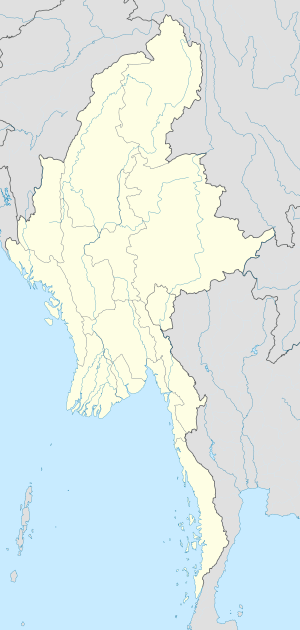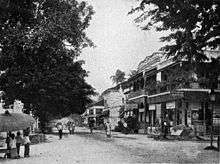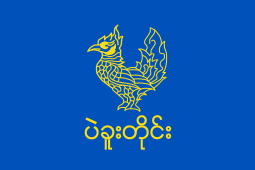Pyay
Pyay (Burmese: ပြည်မြို့; MLCTS: prany mrui., pronounced [pjì mjo̰]; Mon: ပြန်, [prɔn]; also known as Prome and Pyè) is principal town of Pyay Township in the Bago Region in Myanmar. Pyay is located on the bank of the Irrawaddy River, 260 km (160 mi) north-west of Yangon.[1] It is an important trade center for the Ayeyarwady Delta, Central and Upper Myanmar and the Rakhine (Arakan) State.[2] The British Irrawaddy Flotilla Company established the current town in the late 19th century on the Irrawaddy as a transshipment point for cargo between Upper and Lower Burma.
Pyay ဍုၚ်ပြန် Prome | |
|---|---|
City | |
Shwesandaw Pagoda in Pyay | |
 Pyay | |
| Coordinates: 18°49′01″N 95°13′05″E | |
| Country | |
| Division | |
| District | Pyay District |
| Township | Pyay Township |
| Population (2014) | |
| • Urban | 134,861 |
| • Metro | 251,643 |
| Time zone | UTC+6:30 (+6:30) |
The district of Pyay encompasses the valley of the Irrawaddy, located between Thayetmyo, Hinthada and Tharrawaddy districts. Along the western side of Pyay District are the Arakan Mountains and along the eastern side are the Pegu Range. Pyay District's main towns are Pyay, Shwe Taung, and Paungde.
Etymology
The name "Pyay" means "country" in Burmese, and refers to the ruins of the main city of the Pyu city-states, Sri Ksetra (Burmese: သရေခေတ္တရာ, Sanskrit Śrīkṣetra "blessed place, country"), which is located 8 km (5.0 mi) to the south-east of modern Pyay and is in the village of Hmawa.
History
Much debate surrounds the construction of Sri Ksetra. Htin Aung suggests that Pyu might have been founded in 78 CE, based on the Sanskrit / Pyu Era. D. G. E. Hall and Gordon Luce, however, claim that civilisation of the Irrawaddy Valley could not have been possible before the 4th century, thus, attributing the founding of Sri Ksetra to 638, from which the current Burmese Kawza Era begins.
Sri Ksetra was the capital of the Pyu dynasty of Vikrama. The city was circular with walls enclosing about 46 km2 (18 sq mi), making it the largest walled city in Southeast Asia during its peak. The city contained both housing and farms, as is evident from the remains of waterways and tanks which have been discovered.
The Chinese pilgrims Xuanzang and Yijing mentioned Sri Ksetra in their mid-7th-century accounts.[3] It is not known when precisely the Pyu abandoned Sri Ksetra and moved northward. It is speculated that their decline was due to the growth of the Irrawaddy river delta, cutting it off from coastal trade, and also from Mon and later Tai Shan incursions. Burmese chronicles state that when Anawrahta invaded the southern parts of modern-day Myanmar in 1057, he ordered the ruins of Sri Ksetra to be destroyed to prevent rebels from sheltering there. The Burmese came to call the old Pyu center Pyi. The extensive ruins have been the subject of intensive archaeological investigation.

Called Prome by the British (after the name that appears in the Portuguese texts of the XVIIth century), the city became part of British territory after the Second Anglo-Burmese War in 1853. The town was taken by the British in 1825 during the Battle of Prome and again in 1852, on both occasions with hardly any opposition. In 1862, it was almost entirely destroyed by fire, and was afterwards relaid out in straight and broad streets. It was erected into a municipality in 1874, and since then great improvements have been made, including waterworks. During World War II the city was the site of the Battle of Prome. The city was later retaken by the British Army in May 1945.

To the south and south-east, the town is closed in by low pagoda-topped hills, on one of which stands the conspicuous gilded Shwesandaw Pagoda. The Shwesandaw Pagoda is a pagoda in the center of Pyay. It is the terminus for a railway from Yangon, which runs through the district.[4]
To the west of Pyay, crossing Irrawaddy river through Nawaday bridge, stands the Shwebontha Muni Pagoda. The Buddha statue is one of three replica of the Maha Myat Muni Buddha statue, believe to date back 554 B.C. when the king Sandar Thuriy rules.[5]
Geography
The north and north-east of the district is forest-covered, and contains numerous valleys and ravines, which unite in one large stream called the Naweng River. The most important of the plains lie in the south and south-west portions of Pyay, and extend along the whole length of the railway that runs between. There are, in addition large tracts of land covered by jungle, which are available for cultivation. The principal river is the Irrawaddy, which intersects the district from north to south; next in importance are the Thani and its tributaries and the Naweng system of rivers. In the hills near the capital the soil is of Tertiary formation, and in the plains it is an alluvial deposit.
Climate
Pyay has a tropical savanna climate (Köppen climate classification Aw). Temperatures are hot throughout the year, especially in the months before the monsoon from March to May when average maximum temperatures exceed 36 °C (97 °F). The winter months (December–February) are somewhat milder than the rest of the year. There is a winter dry season (December–April) and a summer wet season (May–November). Heavy rain falls in the summer, particularly in the month of July when 626 millimetres (24.6 in) of rain falls.
| Climate data for Pyay (1981–2010) | |||||||||||||
|---|---|---|---|---|---|---|---|---|---|---|---|---|---|
| Month | Jan | Feb | Mar | Apr | May | Jun | Jul | Aug | Sep | Oct | Nov | Dec | Year |
| Average high °C (°F) | 32.2 (90.0) |
35.1 (95.2) |
37.6 (99.7) |
38.7 (101.7) |
36.0 (96.8) |
31.9 (89.4) |
31.0 (87.8) |
31.0 (87.8) |
32.3 (90.1) |
33.5 (92.3) |
32.7 (90.9) |
31.5 (88.7) |
33.6 (92.5) |
| Average low °C (°F) | 16.2 (61.2) |
17.8 (64.0) |
21.2 (70.2) |
24.7 (76.5) |
25.6 (78.1) |
24.8 (76.6) |
24.8 (76.6) |
24.7 (76.5) |
24.6 (76.3) |
24.2 (75.6) |
21.7 (71.1) |
18.1 (64.6) |
22.4 (72.3) |
| Average rainfall mm (inches) | 1.5 (0.06) |
0.9 (0.04) |
5.1 (0.20) |
27.3 (1.07) |
145.1 (5.71) |
234.8 (9.24) |
198.0 (7.80) |
227.5 (8.96) |
205.7 (8.10) |
124.0 (4.88) |
56.0 (2.20) |
1.5 (0.06) |
1,227.4 (48.32) |
| Source: Norwegian Meteorological Institute[6] | |||||||||||||
Economy
The main crop is rice, but some cotton and tobacco are grown, while the custard apples are famous. Sericulture is extensively carried on by a special class. The forests yield teak and cutch, cotton and silk-weaving are important industries; there are also manufactures of ornamental boxes, coarse brown sugar and cutch.
Education
Pyay City has three universities. The universities are Pyay University (PU), ''' Pyay Technological University (PTU), and Computer University, Pyay. Pyay University is situated near to the town centre of Pyay. PTU, which is one of the best ranking University in Myanmar, is situated near to Hnawgone village and Latkhoukpin village, a few miles away from Pyay. CU,Pyay is also quite a far distance from downtown.
Health care
- Pyay General Hospital
- Aung Zaw Oo Hospital
- Myo Thuka Hospital
- Aung Tharaphu Hospital
- Lawkaparla Hospital
References
| Wikivoyage has a travel guide for Pyay. |
| Wikimedia Commons has media related to Pyay. |
- Pyay. (2005). In The Hutchinson Unabridged Encyclopedia including Atlas. Retrieved March 13, 2008, from http://www.credoreference.com/entry/6458618
- "Myanmar Travel Information".
- Cœdès 1968, pp. 62-63,77.
- Bagan: Shwesandaw Pagoda, Myanmar(Burma) Archived 2008-05-17 at the Wayback Machine
- "Shwe Bontha Muni Pagoda".
- "Myanmar Climate Report" (PDF). Norwegian Meteorological Institute. pp. 23–36. Archived from the original (PDF) on 8 October 2018. Retrieved 30 November 2018.
Bibliography
- Cœdès, George (1968). The Indianized States of South-East Asia. University of Hawaii Press. ISBN 978-0-8248-0368-1.CS1 maint: ref=harv (link)
- Htin Aung (1967). A History of Burma. Columbia University Press, 1967.CS1 maint: ref=harv (link)
- Htin Aung; Asoka Society (1970). Burmese history before 1287: a defence of the chronicles. the Asoka Society.CS1 maint: ref=harv (link)
- Stargardt, Janice (1 January 1990). The Ancient Pyu of Burma: Early Pyu cities in a man-made landscape. PACSEA. ISBN 978-1-873178-00-3.CS1 maint: ref=harv (link)
- Thant Myint-U (2011). The River of Lost Footsteps. Faber & Faber. ISBN 978-0-571-26606-7.CS1 maint: ref=harv (link)
Pyay | ||
| Preceded by |
Capital of Prome Kingdom c. November 1482 – 19 May 1542 |
Succeeded by |

